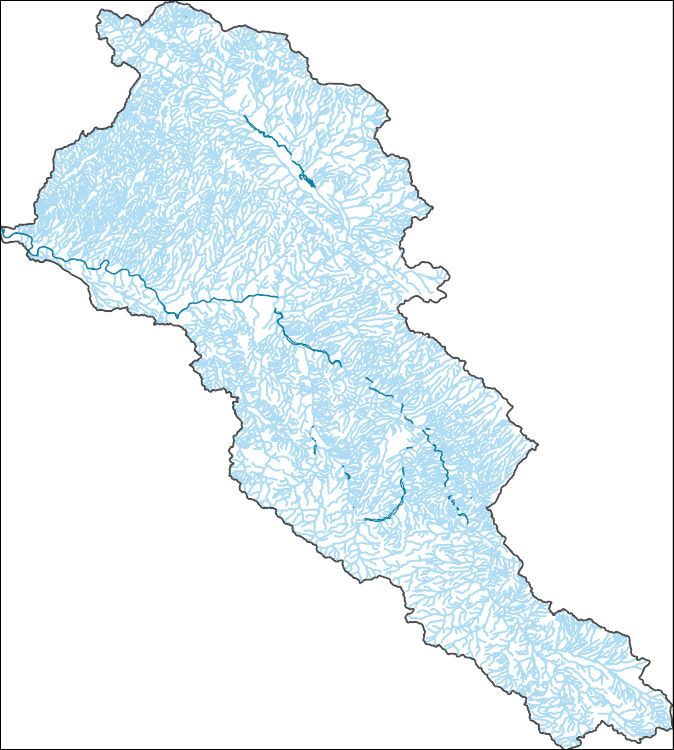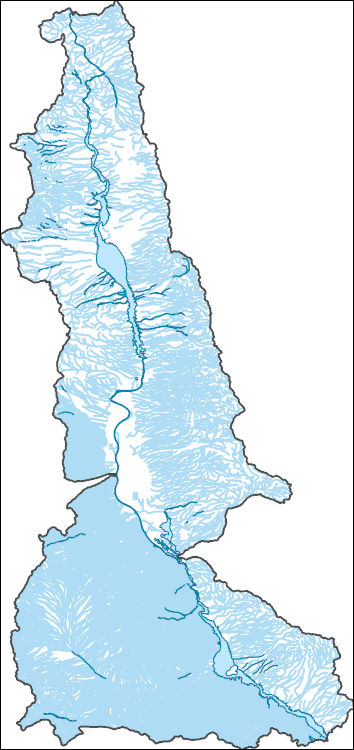Filters: Tags: watershed (X)
8,644 results (142ms)|
Filters
Date Range
Extensions (Less)
Types (Less)
Contacts (Less)
Categories (Less) Tag Types
|
This dataset provides the results of an assessment of estuary habitat condition in the conterminous United States. To analyze estuary condition, a cumulative disturbance index was developed based on habitat stressor variable data available at a national scale for anthropogenic disturbances measured within estuaries and their associated watersheds. Twenty-eight variables were combined within stressor categories to develop four sub-indices of disturbance for land use, alterations of river flows, pollution sources, and estuary eutrophication. These four sub-indices of disturbance were then combined to develop cumulative disturbance index scores for each estuary. This index describes the estimated combined stress on...

This dataset depicts relative erosion rate derived for all land draining above the Mesoamerican reef. It is a function of slope, land cover type, precipitation and soil type. The indicators developed by the Reefs at Risk in the Caribbean project enable detailed comparative analyses of threats on many scales. The Reefs at Risk indicators are a simplification of human activities and complex natural processes. This data set was derived at the World Resources Institute for input to the sedimentation and pollution from watershed based sources threat analysis. Agriculture, though important to economic development and food security, is a source of increased sediment, nutrient, and pesticide runoff. Threats from sedimentation...

Using basins derived from a hydrologically-corrected 30m resolution DEM as a unit for summary statistics, we provide a series of indicators focused on land-based sources of threat within the US Virgin Islands and Puerto Rico. This includes indicators of a) the relative vulnerability of the land to erosion (based on slope, precipitation and soil erodibility); b) the relative erosion potential (REP) of the land, based on the relative vulnerability of the land, coupled with the current land cover type; c) the sediment delivery rate for each basin (percentage of eroded which reaches the river mouth); d) estimated sediment delivery for the basin, given current land use;

This map service contains GIS data in NAD83 projection from the EPA Office of Water for HUC2, HUC4, HUC6, HUC8, HUC10 and HUC12 polygons for the USDA Watershed Boundary Dataset. It is available as a WFS, WMS, and REST service as well as the native MapServer service.

Derived from 1:250,000-scale USGS HUC 8 boundaries, this dataset represents the soil fine gravel fraction for the western USA. A weighted average was created for each HUC 8 watershed using approximate EMAP physical habitat substrate criteria. The values are expressed as percent by weight.

Derived from 1:250,000-scale USGS HUC 8 boundaries, this dataset represents the soil cobble fraction for the western USA. A weighted average was created for each HUC 8 watershed using approximate EMAP physical habitat substrate criteria. The values are expressed as percent by weight.

This assessment presents GIS data containing results of all freshwater assessment analyses conducted by The Nature Conservancy for Washington State. This data set includes values for biodiversity metrics (e.g. suitability, threat, number of species) across all HUC6 watersheds in Washington State, as well as identifies rivers, watersheds, and wetlands that provide the best opportunities for conservation of Washington's native freshwater species and ecological systems. Fore more information, visit waconservation.org .

Compiled 3/23/2011 for the Clearwater Collaborative Analysis Area. The feature class was clipped from the dataset compiled 10/6/2003 for Forest Plan Revision from Clearwater, Nezperce, Bitterroot and Payette National Forest Watershed Coverages.

Description of Work Benthos (benthic invertebrate) and plankton (phytoplankton/zooplankton) communities in Wisconsin's four Lake Michigan Areas of Concern (AOCs; Menominee River, Lower Green Bay and Fox River, Sheboygan River, and Milwaukee Estuary) and six non-AOCs will be quantified. The inclusion of non-AOC sites will allow comparison of AOC sites to relatively-unimpacted or less-impacted control sites with natural physical and chemical characteristics that are as close as possible to that of the AOCs. The community data within and between the AOCs and non-AOCs will be analyzed. This project is a cooperative agreement between the Wisconsin Department of Natural Resources (WDNR) and the US Geological Survey (USGS)....
Categories: Project;
Types: Map Service,
OGC WFS Layer,
OGC WMS Layer,
OGC WMS Service;
Tags: AOC,
Areas of concern,
Beneficial use impairment,
Ecosystem health,
Fox River,

Description of Work USGS will conduct seasonal sampling of benthic invertebrates, zooplankton, prey fish, and their diets to complement the seasonal lower trophic level sampling by EPA. A point of emphasis is describing the vertical distribution of planktivores and their zooplankton prey, to fill a knowledge gap on these predator/prey interactions. These data will provide a more holistic understanding of how invasive-driven, food-web changes could be altering energy available to sport fishes in the Great Lakes and used to build bioenergetics models that can evaluate whether zooplankton dynamics are being driven by limited resources or excessive predation. Understanding the key drivers of zooplankton will provide...
Categories: Project;
Types: Map Service,
OGC WFS Layer,
OGC WMS Layer,
OGC WMS Service;
Tags: Accountability,
CSMI,
Ecosystem health,
Energy transfer,
Fish production,

The National Hydrography Dataset (NHD) is a feature-based database that interconnects and uniquely identifies the stream segments or reaches that make up the nation's surface water drainage system. NHD data was originally developed at 1:100,000-scale and exists at that scale for the whole country. This high-resolution NHD, generally developed at 1:24,000/1:12,000 scale, adds detail to the original 1:100,000-scale NHD. (Data for Alaska, Puerto Rico and the Virgin Islands was developed at high-resolution, not 1:100,000 scale.) Local resolution NHD is being developed where partners and data exist. The NHD contains reach codes for networked features, flow direction, names, and centerline representations for areal water...
Regional regression equations were calculated in Puerto Rico with generalized least squares techniques to estimate flood frequency statistics at ungaged locations using drainage area as the only explanatory variable. The island was divided into 2 regions to minimize residuals. The region division that resulted in lower and more balanced residuals runs primarily north-south near the center of the island, mostly along an 8-digit hydrologic unit code (HUC8) boundary. The division line runs through a HUC8 polygon on the southern end of the island, but care was taken to include entire watersheds and consideration was given where hydrologic and physiographic properties differed. This data release includes geographic information...
Types: Map Service,
OGC WFS Layer,
OGC WMS Layer,
OGC WMS Service;
Tags: HUC,
Puerto Rico,
WBD,
Watershed,
Watershed Boundary Dataset,
Summary Analysis of historical streamflow trends and their relationship to landscape characteristics is essential for understanding geographic differences in runoff within the Great Lakes basin and for distinguishing temporal trends from temporal variance. Factor analysis of streamflow records (1956–1988) from 32 US Geological Survey gauging stations within the Great Lakes basin revealed distinct spatio-temporal patterns of stream runoff within five different regions of the basin. Streams represented by the first annual factor occurred in southern Wisconsin and the lower peninsula of Michigan, and exhibited a linear increase in mean annual streamflow over the 33 year period caused by increased autumn and winter...
Categories: Publication;
Types: Citation;
Tags: Data Visualization & Tools,
Discharge,
Factor analysis,
Landscape,
Landscapes,
This raster dataset represents the boundaries of the hydrogeologic areas of the Southwest Principal Aquifer (SWPA) study of the National Water Quality Assessment (NAWQA) program. It is a compilation of the pre-existing Hydrogeologic Areas of the Southwest Ground-Water Resources Project, with additional data from the Central and Coastal basins of California, Northern New Mexico Rio Grande Valley, and South Central Colorado San Luis Valley.
This data set is a complete digital hydrologic unit boundary layer to the Subwatershed (12-digit) 6th level for the entire United States. This data set consists of geo-referenced digital data and associated attributes created in accordance with the "Federal Guidelines, Requirements, and Procedures for the National Watershed Boundary Dataset; Chapter 3 of Section A, Federal Standards, Book 11, Collection and Delineation of Spatial Data; Techniques and Methods 11-A3" (04/01/2009). http://www.ncgc.nrcs.usda.gov/products/datasets/watershed/index.html . Polygons are attributed with hydrologic unit codes for 4th level sub-basins, 5th level watersheds, 6th level subwatersheds, name, size, downstream hydrologic unit, type...
The NHDPlus Version 1.0 is an integrated suite of application-ready geospatial data sets that incorporate many of the best features of the National Hydrography Dataset (NHD) and the National Elevation Dataset (NED). The NHDPlus includes a stream network (based on the 1:100,000-scale NHD), improved networking, naming, and "value-added attributes" (VAA's). NHDPlus also includes elevation-derived catchments (drainage areas) produced using a drainage enforcement technique first broadly applied in New England, and thus dubbed "The New-England Method". This technique involves "burning-in" the 1:100,000-scale NHD and when available building "walls" using the national Watershed Boundary Dataset (WBD). The resulting modified...

The National Hydrography Dataset (NHD) is a feature-based database that interconnects and uniquely identifies the stream segments or reaches that make up the nation's surface water drainage system. NHD data was originally developed at 1:100,000-scale and exists at that scale for the whole country. This high-resolution NHD, generally developed at 1:24,000/1:12,000 scale, adds detail to the original 1:100,000-scale NHD. (Data for Alaska, Puerto Rico and the Virgin Islands was developed at high-resolution, not 1:100,000 scale.) Local resolution NHD is being developed where partners and data exist. The NHD contains reach codes for networked features, flow direction, names, and centerline representations for areal water...

The National Hydrography Dataset (NHD) is a feature-based database that interconnects and uniquely identifies the stream segments or reaches that make up the nation's surface water drainage system. NHD data was originally developed at 1:100,000-scale and exists at that scale for the whole country. This high-resolution NHD, generally developed at 1:24,000/1:12,000 scale, adds detail to the original 1:100,000-scale NHD. (Data for Alaska, Puerto Rico and the Virgin Islands was developed at high-resolution, not 1:100,000 scale.) Local resolution NHD is being developed where partners and data exist. The NHD contains reach codes for networked features, flow direction, names, and centerline representations for areal water...

The National Hydrography Dataset (NHD) is a feature-based database that interconnects and uniquely identifies the stream segments or reaches that make up the nation's surface water drainage system. NHD data was originally developed at 1:100,000-scale and exists at that scale for the whole country. This high-resolution NHD, generally developed at 1:24,000/1:12,000 scale, adds detail to the original 1:100,000-scale NHD. (Data for Alaska, Puerto Rico and the Virgin Islands was developed at high-resolution, not 1:100,000 scale.) Local resolution NHD is being developed where partners and data exist. The NHD contains reach codes for networked features, flow direction, names, and centerline representations for areal water...
|

|